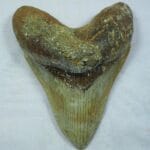Prepare to dive into the captivating rivalry of Livyatan and Megalodon, two massive marine predators from prehistoric times. We’ll explore their sizes, hunting strategies, and anatomical advantages as we uncover the intriguing question: who would win if these ancient titans met in a battle for the ages? Step into the ancient seas and witness the hypothetical clash between Livyatan, the colossal whale hunter, and Megalodon, the largest shark to ever prowl the oceans.
The Contenders: A Tale of Two Predators
Before we pit these titans against each other, let’s get to know them. In one corner, we have Livyatan melvillei, a name that echoes the biblical sea monster, Leviathan, and pays homage to Herman Melville, the author of Moby Dick. And for good reason. This prehistoric sperm whale, measuring up to 57 feet long and weighing an estimated 50 tons, was a behemoth of the ancient seas. Its massive skull and jaws housed teeth exceeding a foot in length—the largest biting teeth of any known animal—perfectly designed to crush the bones of its preferred prey: baleen whales.
In the other corner stands the legendary Megalodon (Otodus megalodon), its very name a chilling whisper of “big tooth.” This extinct giant shark, reaching estimated lengths of 45-60 feet and weighing up to 60-70 tons (though estimates vary), was the undisputed ruler of its time. Its powerful jaws, armed with serrated teeth designed for tearing flesh, could deliver one of the most powerful bites of any creature to ever exist.
Imagine these two titans, each a formidable force of nature, circling each other in the prehistoric depths. What happens when their worlds collide?
Size and Bite Force: A Titanic Clash
When it comes to sheer size, Megalodon likely had the upper hand, potentially reaching lengths exceeding twice that of a school bus. However, Livyatan, while possibly shorter, was likely heavier, built more like a muscular tank compared to Megalodon’s sleeker, shark-like frame.
Megalodon’s bite, however, remains the stuff of legends. Scientists estimate its bite force could exceed 18 tons, enough to pulverize a car with a single snap. Its serrated teeth, exceeding seven inches in length, were designed to slice through flesh and bone, delivering devastating wounds.
Livyatan, however, takes a different approach to devastation. Its massive teeth, some exceeding a foot in length, were built for crushing bone. Imagine a bite capable of pulverizing a whale skull in a single, earth-shaking crunch!
Hunting Styles: Brains vs. Brawn?
While we can only speculate about the specific behaviors of these extinct giants, fossil evidence and comparisons to modern relatives provide tantalizing clues. Livyatan’s skull suggests it possessed a well-developed sense of echolocation, similar to modern-day dolphins. This ability, combined with its size, hints at the possibility of cooperative hunting, perhaps using coordinated attacks to overwhelm even the largest prey. This social hunting strategy, employed by modern-day dolphins and whales, suggests that Livyatan might have been a highly intelligent predator.
Megalodon, on the other hand, was likely a solitary hunter, much like its distant relative, the great white shark. Its massive size, combined with potential camouflage and a streamlined body, may have allowed it to ambush prey from below, delivering a sudden and fatal blow.
Speed and Agility: The Race for Survival
Reconstructing the speed of extinct marine animals is a complex task, but anatomical clues offer some hints. Megalodon’s streamlined body and powerful tail suggest it was a swift and powerful swimmer, capable of bursts of speed when pursuing prey.
While Livyatan, with its larger size and robust build, may not have been as inherently fast as Megalodon, it likely possessed impressive maneuverability for its size. This agility would have been essential when navigating the chaotic underwater battles that likely defined its existence.
Did Their Paths Cross?
Livyatan and Megalodon lived during overlapping periods, roughly 12 to 3 million years ago, and shared similar territories in the world’s oceans. This overlap, combined with their shared taste for large marine animals, suggests that encounters between these two apex predators were not only possible but likely inevitable.
Fossil evidence reveals that Livyatan actively hunted baleen whales, a food source likely also targeted by Megalodon. This competition for resources could have led to direct confrontations between the two titans.
Imagine: a lone Megalodon, drawn by the scent of a whale carcass, stumbles upon a pod of Livyatan already feasting. Would the shark risk challenging the group of whales, or would it retreat and seek easier prey?
While no direct fossil evidence, such as bite marks, confirms direct conflict between Livyatan and Megalodon, the possibility of such encounters remains a tantalizing area of exploration for paleontologists.
Who Would Win: A Battle for the Ages?
So, the ultimate question remains: who would win in a fight between Livyatan and Megalodon? The truth is, there’s no easy answer. Each predator possessed its own unique advantages and disadvantages.
- Megalodon: Greater size and speed, a more powerful bite, and serrated teeth designed for tearing flesh.
- Livyatan: Comparable weight, potentially greater intelligence and social hunting capabilities, and massive bone-crushing teeth.
The outcome of a battle would likely depend on a complex interplay of factors, including:
- The environment: Open ocean versus shallower coastal waters could favor one predator over the other.
- The element of surprise: An ambush predator like Megalodon might have the advantage if it struck first.
- Individual size and experience: A larger, older, and more experienced individual of either species would likely hold an advantage.
Ultimately, imagining this clash of titans remains a captivating thought experiment. It reminds us of the incredible power and diversity of life that once filled Earth’s ancient oceans. As we continue to unearth new fossils and unravel the mysteries of the past, we gain a deeper appreciation for the awe-inspiring creatures that once ruled the planet.
To learn more about the battle between these ancient marine titans, check out megalodon vs livyatan.
Read marsden and geiger to understand the historical significance of this deadly duo.
- Discover Long Black Pepper: Flavor & Health Benefits - April 25, 2025
- Shocking Twists: The Grownup Review: Unreliable Narration - April 25, 2025
- A Quiet Place Book vs Movie: A Deep Dive - April 25, 2025















